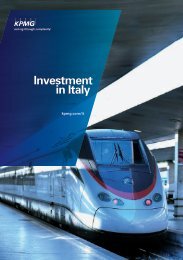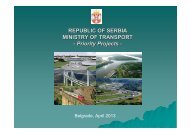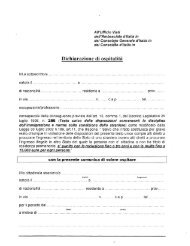Innovation Canada: A Call to Action
Innovation Canada: A Call to Action
Innovation Canada: A Call to Action
Create successful ePaper yourself
Turn your PDF publications into a flip-book with our unique Google optimized e-Paper software.
<strong>Innovation</strong> <strong>Canada</strong>: A <strong>Call</strong> <strong>to</strong> <strong>Action</strong>Box 6.2 Key Parameters of the SR&ED Tax Incentive ProgramNature and PurposeThe SR&ED program seeks <strong>to</strong> encourage Canadian businesses of all sizes and in all sec<strong>to</strong>rs <strong>to</strong>conduct R&D in <strong>Canada</strong> that will lead <strong>to</strong> new, improved or technologically advancedproducts or processes. The program offers two types of incentives:Income tax deductions — All allowable SR&ED expenditures, including capital, may bededucted from taxable income in the year incurred at the taxpayer’s discretion; unuseddeductions may be carried forward indefinitely. R&D spending is generally considered <strong>to</strong>be an investment — that is, the spending is undertaken in one period with theexpectation of generating revenues in future periods — so allowing immediatedeductibility of capital and current expenditures provides a significant benefit <strong>to</strong> firms.Investment tax credits — Earned as a percentage of qualified SR&ED expenditures,investment tax credits can be used <strong>to</strong> reduce the amount of income taxes otherwisepayable. They can be carried back up <strong>to</strong> three years and forward up <strong>to</strong> 20 years <strong>to</strong> reduceincome taxes otherwise payable in those years. Credits earned in a year but not used arepartially or fully refundable (that is, redeemed for cash) for smaller businesses.EligibilityParticipants: corporations, proprie<strong>to</strong>rships (individuals), partnerships and trustsCosts: Salaries and wages, overhead expenses, materials, capital equipment expenses,contracts and payments <strong>to</strong> third parties such as post-secondary institutionsProjects: experimental development, basic and applied research, and support work (suchas engineering design and operations research) carried out for the purpose of achievingtechnological advancement or advancing scientific knowledge.AdministrationAdministration is the responsibility of the <strong>Canada</strong> Revenue Agency (CRA), while governinglegislation (Income Tax Act) is the responsibility of the Department of Finance. Firms file aSR&ED claim for their eligible expenditures incurred. The CRA reviews the claim, and aims <strong>to</strong>process 90 percent of refundable claims within 120 days of receipt and 90 percent of nonrefundableclaims within 365 days of receipt. The CRA offers a preclaim advisory service <strong>to</strong>help businesses identify the eligibility of projects. It is available at no cost before claims arefiled. As noted on the CRA website, the preclaim service is “neither an advanced income taxruling nor a pre-approval of a SR&ED claim. A final determination on any SR&ED claim mustbe based on the actual work done and can only be made after the claim is filed.”growth in the number of small CCPCs in 2007may have been due <strong>to</strong> an increase of thetaxable income threshold that allows a company<strong>to</strong> qualify for the enhanced credit. Due <strong>to</strong> theirhigher credit rate and refundability, small CCPCsclaimed about 40 percent of <strong>to</strong>tal credits whileperforming about 30 percent of qualifyingR&D in 2007.The SR&ED program, unlike grant programs, isnot subject <strong>to</strong> assessment of the quality of anyparticular business project. Businesses that donot qualify for a refundable credit nevertheless6-6
















